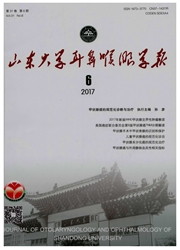

 中文摘要:
中文摘要:
目的通过建立部分去除黏膜层的游离空肠段重建6.5cm袖状气管缺损动物模型,从而研究部分去黏膜游离空肠修复犬气管缺损前后气管黏液清除率的变化。方法比格犬8只,从腹部取长约7cm的带蒂游离空肠段,部分去除空肠的黏膜层。将部分去黏膜游离空肠联合肠腔内放置硅胶管内支架,空肠外面放置形状记忆镍钛合金(SMA)外支架,应用显微吻合技术,将游离空肠的系膜动静脉分别与右侧颈总动脉及颈内静脉相吻合,建立长段气管重建动物模型。分别于术前1周、术后1周、术后1个月、术后3个月,静脉全麻下犬仰卧位,纤维支气管镜下于重建气道(术前大约为环状软骨下约7.0cm处)的下切缘用注射器滴入示踪剂,计算示踪剂从滴入到到达声门的时间(MTT)除该段长度(MTL)为黏液清除率(MTR),并对结果进行统计学分析。结果8只犬黏液清除功能观测术前与术后1个月、3个月,术后1个月与术后3个月的MTR相比差异无统计学意义(P〉0.05),术前MTR与术后1周、术后1个月与术后1周、术后3个月与术后1周相比差异均有统计学意义(P〈0.01)。结论部分去黏膜游离空肠重建气管后气管黏液清除率术后1个月可恢复到术前的水平,术后3个月保持与术前、术后1个月相当的黏液清除功能。
 英文摘要:
英文摘要:
Objective To establish an animal model to study the changes of tracheal mucociliary transport before and after trachea reconstruction, in which a 6.5 cm segment of cervical trachea was replaced by jejunal autograft with par tially scraped mucosa. Methods Eight beagle dogs were included in the study. A 6.5 cm segment of cervical trachea was resected. Through a midline abdominal incision, 7 cm jejunum was resected and the graft was prepared by scraping partial mucosa off with surgical knife and dry gauze. Microvascular anastomoses were done between the mesenteric ar tery and the fight common carotid artery, using a standard end-to-side technique. The mesenteric vein was anastomosed with the fight common carotid vein, using a standard end-to-end technique. The silicone stent was placed in the lumen of the jejunal segment and removed four week later after the operation. A Ni-Ti alloy prothesis was placed over the jeju nal segment, with the mesenteric vessels passing through the longitudinal opening of the mesh tube. In every canine model, the position of lower margin of resected trachea was marked in cervical skin and 50% barium sulfate mucilage was injected as a tracer into the trachea lumen under fiberoptic bronchoscopy. The time between the injection and arrival of tracer to glottis (mucociliary transit time, MTT) and corresponging length of travel (mucociliary transport length, MTL) were recorded. Mucociliary transit rate (MTR), as MTL/MTT, was calculated. The same procedure was per formed before operation and 7 days, 1 month and 3 months postoperatively. Statistical analysis was performed. Results There was no difference in MTR before operation and 1 month, 3 months after operation, and there was also nodifference in MTR between 1 month and 3 months postoperatively( P 〉 0.05 ). Statistical significance in MTR were not ed between all the neighboring two time points, from preoperative MTR, 1-week , 1 month and 3 months postoperative (P 〈 0.05). Conclusion In the tracheal reconstruction by
 同期刊论文项目
同期刊论文项目
 同项目期刊论文
同项目期刊论文
 期刊信息
期刊信息
